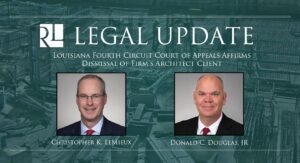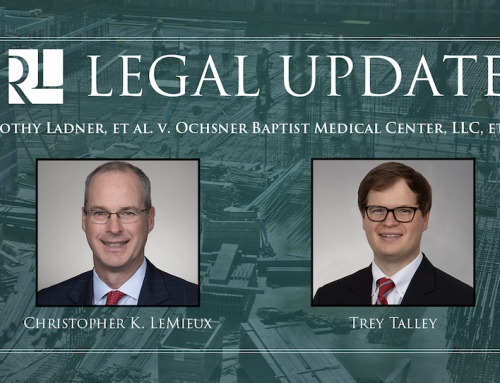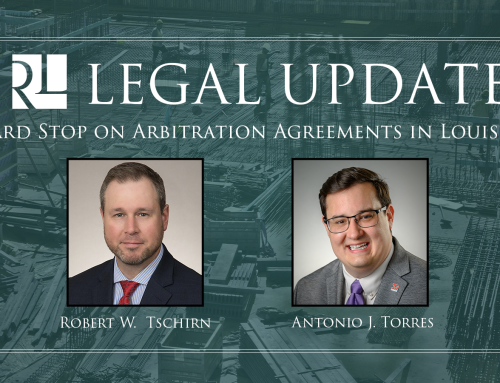Louisiana Fourth Circuit Court of Appeals Affirms Dismissal of Firm’s Architect Client.
 Attorneys: Christopher K. LeMieux and Donald C. Douglas, Jr.
Attorneys: Christopher K. LeMieux and Donald C. Douglas, Jr.
Riess LeMieux attorneys Christopher K. LeMieux and Donald C. Douglas, Jr. recently obtained a favorable ruling from the Louisiana Fourth Circuit Court of Appeals affirming the dismissal of an architect client of the firm.
The lawsuit at issue arose from a hotel development in the warehouse district of New Orleans. The Owner entered into a standard AIA form A101 Contract with the General Contractor, and a separate AIA form B101 Agreement with the Architect.
The Owner, without involvement of the Architect, terminated the General Contractor on the Project. The General Contractor then filed a lien against the property, and the Owner filed a lawsuit seeking to have the lien set aside. The General Contractor was named as a defendant and attempted to bring a third-party demand against the Architect for damage it allegedly sustained during the course of the Project, including but not limited to the termination. LeMieux and Douglas filed several exceptions to the third-party demand of the General Contractor, including an Exception of Prescription alleging that any tort claims against the Architect were untimely because the third-party demand had been filed well over a year after any alleged negligence of the Architect. Further, LeMieux and Douglas filed an Exception of No Right of Action and No Cause of Action on behalf of the Architect, arguing that in addition to the tort claims being time barred, the Contract between the Owner and the General Contractor and the separate Agreement between the Owner and the Architect specifically precluded any contract-based claims between the Architect and the General Contractor.
Importantly, the two contracts contained “integration” provisions. The AIA A101 Contract between the Owner and General Contractor contained a provision which specifically provided that nothing in the contract documents could be construed to create a contractual relationship between the General Contractor and the Architect. The AIA B101 Agreement between the Owner and the Architect contained its own provision providing that nothing in that contract would create either a contractual relationship or a cause of action in favor of a third-party against the Architect. The District Judge, citing the contractual provisions, agreed with the arguments made on behalf of the Architect and granted both the Exception of No Right of Action and No Cause of Action, and dismissed all claims by the Contractor against the Architect.
The General Contractor appealed the dismissal. The Louisiana Fourth Circuit Court of Appeal affirmed the dismissal of the Architect, relying on the integration provisions contained in both of the contracts. The Court of Appeal noted that while tort claims could possibly exist between the Architect and the General Contractor, the integration provisions precluded any contract-based claim from being asserted. The General Contractor also tried to convince the Court of Appeal that it should be allowed to bring a detrimental reliance claim against the Architect. The Court of Appeal rejected this argument as well, finding that to the extent any detrimental reliance claim had arisen in tort, it was prescribed. Further, as the contractual documents contained the integration provisions, the court held that such contracts precluded a detrimental reliance claim to the extent that it sounded in contract.
This success for the firm’s client also highlights the importance of filing tort claims timely regarding issues that arise on construction project between parties that are not in contract with one another. Otherwise, such tort claims may be prescribed.



